La Sagrada Familia or simply Sagrada Familia is a famous Roman Catholic minor basilica in Barcelona, Spain. It is one of the most visited landmarks in the city, attracting millions of tourists every year. The basilica is known for its unique and artistic design, created by the popular architect Antoni Gaudí. The construction of La Sagrada Familia began in 1882 and is still ongoing today. It is expected to be completed by 2026, the centenary of Gaudí’s death. The basilica has taken longer to build than some of the world’s ancient wonders, such as the Egyptian Pyramids. Sagrada Familia consists of three grand façades, each representing a different aspect of the life of Jesus Christ: the Nativity, the Passion, and the Glory. The façades are filled with intricate sculptures and symbols, reflecting Gaudí’s vision and religious devotion. The interior of Sagrada Familia is equally impressive, featuring a forest-like structure of columns, vaults, and stained glass windows. The basilica also has a museum, a school, and a crypt, where Gaudí is buried. Visitors can enjoy the beauty and history of Sagrada Familia by booking a guided tour or an audio guide for $28 (€25.48, £24.36).
What is the Sagrada Familia?
Sagrada Familia is a basilica located in Barcelona, Spain. It is the largest unfinished Catholic church in the world. The construction of La Sagrada Familia began on March 19, 1882. It was designed by famous Catalan architect Antoni Gaudí, who took over as the chief architect in 1883 and devoted the remainder of his life to the project. At the time of Gaudí’s death in 1926, less than a quarter of the project was complete. The basilica is in the district of Eixample in Barcelona. Sagrada Familia is a prominent landmark that attracts numerous visitors worldwide and has become an iconic symbol of Barcelona. Sagrada Familia has a planned height of 566 feet (172.5 meters). Its length measures 300 feet (90 meters), and its width is 200 feet (60 meters). The basilica has 18 spires, 13 of which have already been built, and has a capacity of 9,000 people. The construction of La Sagrada Familia has faced various challenges and delays throughout the years, and it is currently estimated that some aspects of the project may only be finished by 2026. The construction is funded by the entrance fees paid by visitors, contributing to the annual budget of $29 million (€26.39 million, £25.23 million).
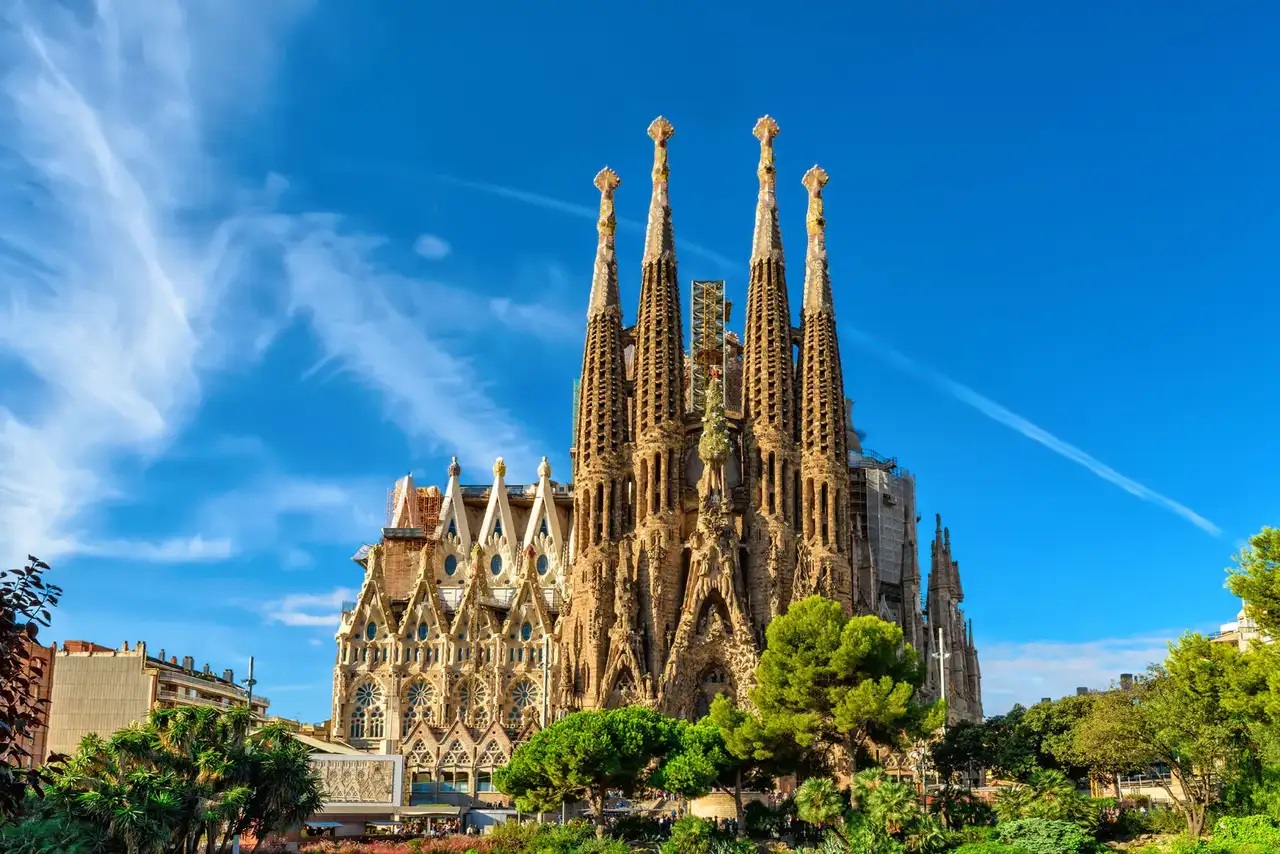
What architectural style is most prominent in the Sagrada Familia?
The most prominent architectural style in the Sagrada Familia is Catalan Modernism, also known as Art Nouveau. The architectural style was popular in the late 19th and early 20th centuries and is characterized by its organic shapes, intricate ornamentation, and integration of natural elements. The architect of La Sagrada Familia, Antoni Gaudí, was a prominent figure in the Catalan Modernism movement, and his unique style is evident in the basilica’s design. Sagrada Familia showcases many characteristic features of Catalan Modernism. The basilica’s exterior is filled with intricate sculptures, colorful ceramic tiles, and ornamental details inspired by nature. The use of curved lines and dynamic forms creates a sense of movement and vitality in the building’s design. Gaudí also incorporated elements from Gothic architecture, such as pointed arches and ribbed vaults, giving the basilica a blend of styles characteristic of his work. The interior of La Sagrada Familia is equally remarkable and reflects Gaudí’s innovative approach to design. The soaring columns and vaults create a sense of grandeur, while light and color create a unique atmosphere. The stained glass windows, in particular, are a defining feature of the basilica, casting a mesmerizing play of colors and patterns. Gaudí’s attention to detail is evident in every aspect of the interior, from the intricately carved ornamentation to the carefully planned acoustics.
What structural engineering principles are employed in the construction of the Sagrada Familia?
There are 4 major structural engineering principles that are employed in the construction of the Sagrada Familia. Firstly, the architect Antoni Gaudí implemented the principle of a hyperboloid structure in the design of La Sagrada Familia. The structural form consists of intersecting hyperbolic shapes that provide strength and visual appeal. The hyperboloid design allows for the distribution of loads along the surfaces, minimizing stress concentrations and enhancing the overall structural integrity of the building. Secondly, reinforced concrete is extensively used to construct Sagrada Familia. The material combines concrete’s compressive strength with steel reinforcement’s tensile strength. Reinforced concrete columns, beams, and walls ensure the building can withstand various external forces, such as wind and seismic loads. The construction technique has proven to be cost-effective and provides long-term durability. Thirdly, the concept of a self-supporting structure is a key principle employed in La Sagrada Familia’s construction. Gaudí envisioned a design where each part of the building supports itself and transfers the loads to the ground. The approach eliminates the need for extensive external supports, allowing open and spacious interiors. The use of inclined columns and innovative structural solutions, such as hanging models, contributes to the self-supporting nature of the building. Lastly, the incorporation of advanced computer modeling and analysis techniques played a significant role in the construction process of La Sagrada Familia. Modern structural engineering practices, including finite element analysis, were employed to simulate and assess the behavior of the structure under different load conditions. These tools aided in optimizing the design, ensuring structural stability, and enhancing the overall safety of the building.
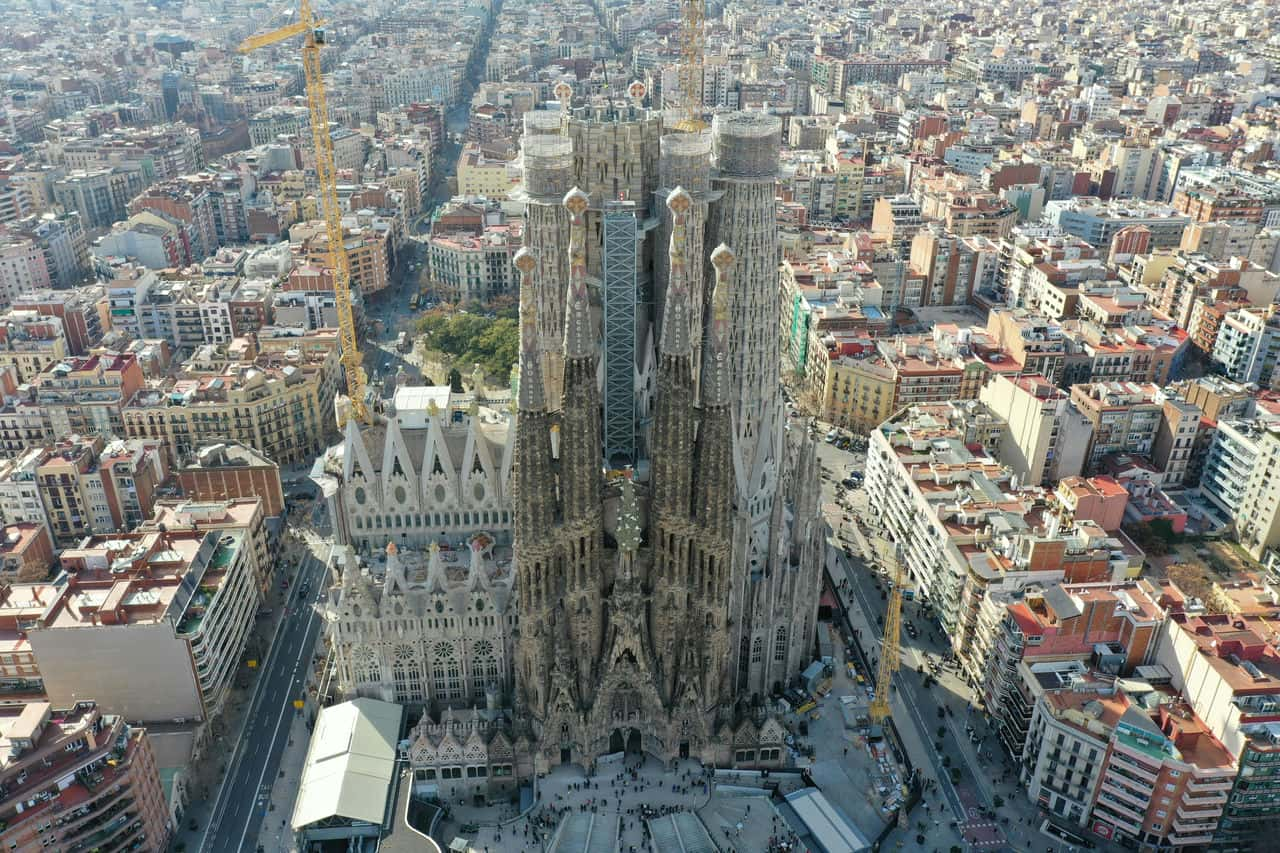
Who designed the Sagrada Familia?
Sagrada Familia was designed by the architect Antoni Gaudí. Gaudí, a prominent figure in Catalan Modernism, was responsible for the initial design and subsequent development of the iconic basilica. He dedicated over 40 years to the project until his untimely death in 1926. Sagrada Familia’s design shows Gaudí’s unique artistic vision and innovative architectural style. He drew inspiration from natural forms and incorporated organic shapes and motifs into the building’s structure and ornamentation. Gaudí’s aim was to create a harmonious blend of architecture and nature, resulting in a truly distinctive and breathtaking edifice. Gaudí’s design for Sagrada Familia was characterized by intricate details, expressive sculptures, and a combination of Gothic and Art Nouveau elements. His approach to architecture was deeply rooted in his religious beliefs, and he sought to create a sacred space that would inspire awe and reverence. Despite his passing, Gaudí’s vision continues to guide the ongoing construction and completion of La Sagrada Familia, which is expected to be finished in 2026.
What are the historical design influences visible in the Sagrada Familia?
There are 4 major historical design influences visible in the Sagrada Familia. Firstly, the Gothic architectural style heavily influenced the design of La Sagrada Familia. It can be seen in the verticality of the building, pointed arches, ribbed vaults, and the emphasis on light and height. Gaudí drew inspiration from the grandeur and elegance of Gothic cathedrals, incorporating these elements into the design of La Sagrada Familia to create a sense of divine transcendence. Secondly, the Art Nouveau movement, also known as Modernisme in Catalonia, significantly impacted the design of La Sagrada Familia. Gaudí, a prominent figure of the artistic movement, brought his innovative and organic design principles to the basilica. The use of flowing lines, intricate ornamentation, and incorporation of elements from nature, such as plants and animals, reflects the Art Nouveau aesthetic in the architecture of Sagrada Familia. Thirdly, medieval Spanish architecture, particularly the Mudéjar style, influenced the design of La Sagrada Familia. Gaudí drew inspiration from the ornamental details and geometric patterns found in Mudéjar architecture, incorporating them into the facades and interior of the basilica. The use of colorful ceramic tiles, intricate brickwork, and decorative elements reminiscent of Islamic and Spanish architectural traditions can be observed in various parts of the building. Lastly, the influence of Catalan architectural traditions is evident in Sagrada Familia. Gaudí, being a Catalan architect, aimed to create a symbol of Catalan identity and pride through his design. He incorporated elements from Catalan architecture, such as trencadís (mosaic made from broken tile shards) and the integration of Catalan symbols and motifs, showcasing his commitment to honoring the local heritage and culture.
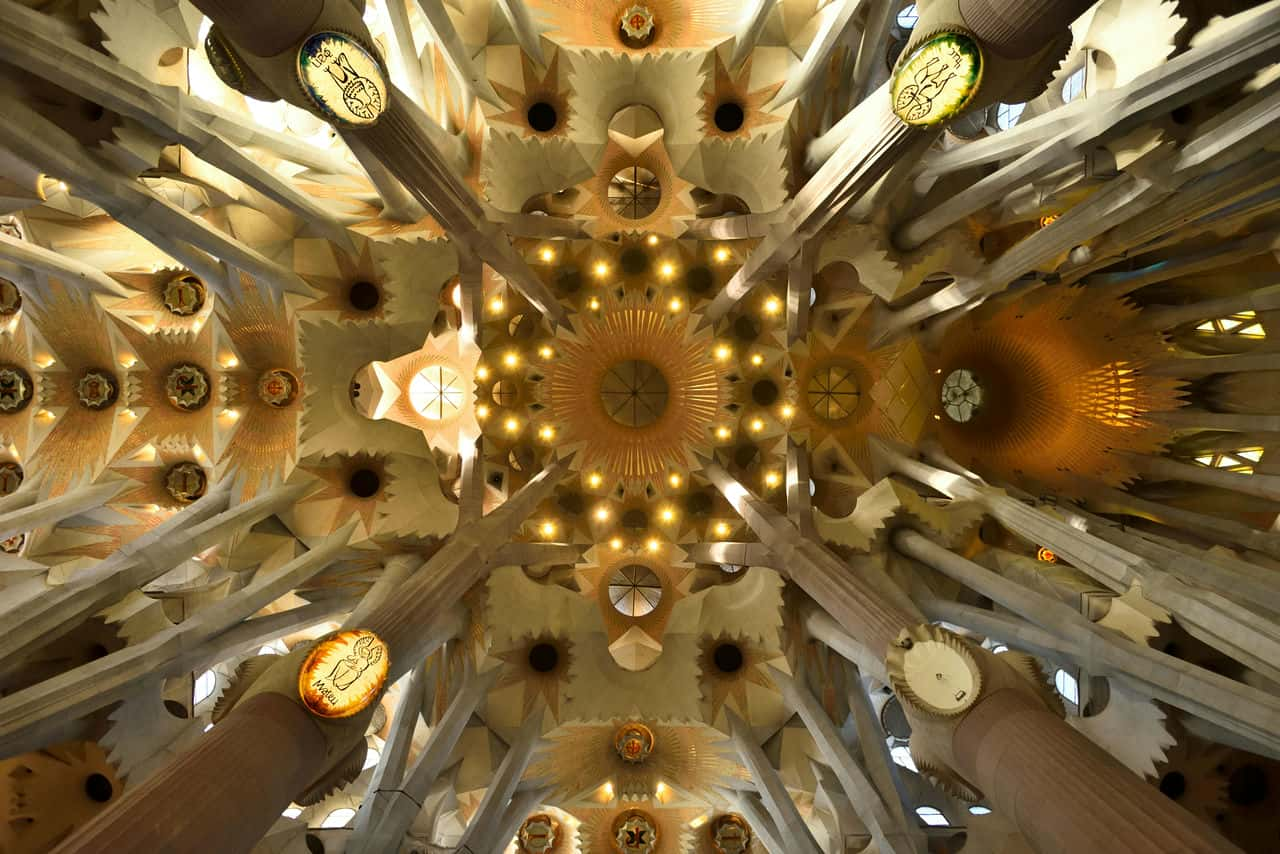
How has the Sagrada Familia influenced the design of other buildings in Spain?
The Sagrada Familia influenced the design of other buildings in Spain in 4 ways. Firstly, Sagrada Familia has influenced innovative structural techniques in contemporary Spanish architecture. Architects have been inspired by Antoni Gaudí’s use of reinforced concrete and his exploration of different construction methods. The basilica’s incorporation of self-supporting structures, hyperboloid forms, and creative use of materials has influenced the design of other buildings, particularly in terms of structural experimentation and the application of advanced engineering principles. Secondly, the artistic and aesthetic elements of Sagrada Familia have influenced architectural design in Spain. The intricate ornamentation, organic forms, and incorporation of natural elements in Gaudí’s masterpiece have inspired architects to explore more expressive and artistic approaches. The use of flowing lines, colorful mosaic work, and incorporation of symbolism from nature have become hallmarks of Spanish architecture influenced by Sagrada Familia. Thirdly, the concept of blending historical and modern design elements has been influenced by Sagrada Familia. Architects in Spain have drawn inspiration from Gaudí’s ability to harmoniously integrate Gothic, Art Nouveau, and Catalan architectural traditions into a contemporary structure. The fusion of historical influences with modern design sensibilities can be seen in various buildings across the country, as architects strive to create structures that pay homage to the past while embracing innovation. Lastly, Sagrada Familia’s status as an iconic landmark has influenced the design of public buildings and religious structures in Spain. Its grand scale, cultural significance, and spiritual symbolism have set a precedent for monumental architecture. Architects have sought to create buildings that evoke a sense of awe and reverence, often incorporating unique design elements and striving for architectural excellence inspired by the impact of Sagrada Familia on the Spanish architectural landscape.
What purpose does the Sagrada Familia serve, and how does the design help?
La Sagrada Familia is a significant religious and cultural landmark in Barcelona, Spain. It is a basilica dedicated to the Holy Family, and its purpose is to provide a space for religious worship, contemplation, and spiritual connection. The design of La Sagrada Familia helps create a sense of awe and reverence. The grandeur and scale of the basilica, with its soaring towers and intricate details, evoke a feeling of transcendence. Inspired by Gothic architecture, the structure’s verticality draws the gaze upward and emphasizes the connection between the earthly realm and the divine. The design elements, such as the use of light and the integration of natural forms, contribute to a spiritual ambiance that enhances the religious experience for visitors. Sagrada Familia’s design facilitates the faithful’s engagement. The basilica’s interior is carefully designed to create a sense of intimacy and focus. Light-filtering stained glass windows bathes the space in a warm and ethereal glow, creating a captivating atmosphere for prayer and reflection. The incorporation of symbolic elements and religious motifs throughout the building, such as sculptures and ornamental details, helps to convey and reinforce the religious narrative, enabling worshippers to connect with the spiritual themes and narratives represented in the design. The design of La Sagrada Familia serves as a testament to the devotion and faith of the community. The ongoing construction of the basilica, which began over a century ago and continues to this day, reflects a commitment to the realization of a shared vision. The design’s intricate details and innovative techniques showcase the dedication and craftsmanship of the architects, artisans, and builders involved in the project. The unfinished nature of the basilica also serves as a reminder of the continuous spiritual journey and ongoing work of faith.
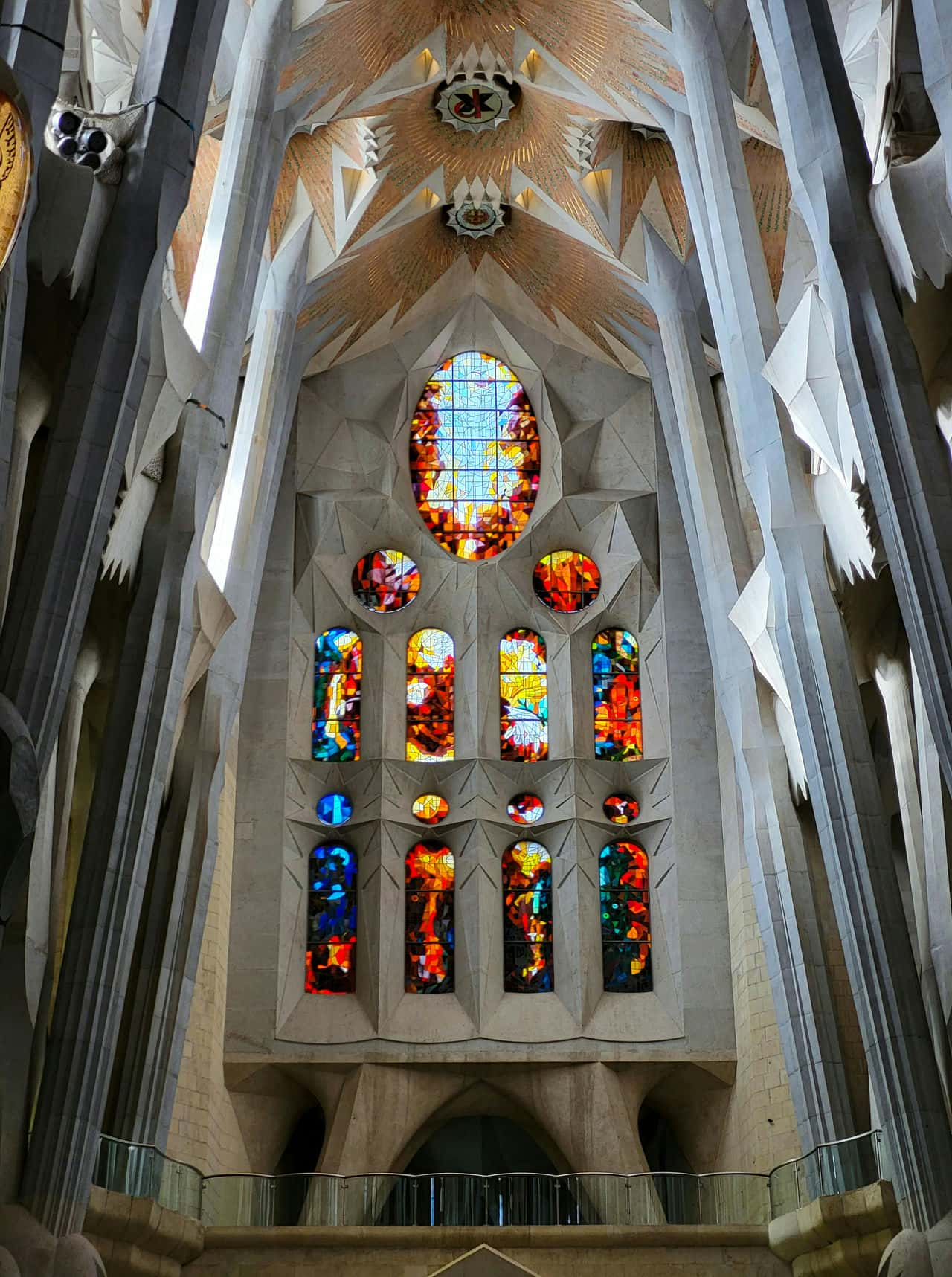
How is the Sagrada Familia maintained?
Sagrada Familia is maintained through conservation efforts, ongoing construction work, and dedicated teams responsible for its upkeep. Regular conservation work is carried out to preserve and protect the basilica’s architectural elements, including cleaning and restoration of the intricate façades, sculptures, and ornamental details. Specialized teams conduct careful inspections to identify any signs of deterioration, such as cracks or weathering, and take appropriate measures to address them. The use of advanced techniques and materials ensures that the original design intent is maintained while safeguarding the structure from external factors. The ongoing construction of La Sagrada Familia plays a crucial role in its maintenance. The basilica has been under construction for over a century, and efforts continue to complete Gaudí’s vision. Construction teams of skilled craftsmen and engineers work on various aspects of the basilica, including constructing new towers and completing interior spaces. The construction work not only progresses the project but also allows for continuous monitoring and maintenance of existing areas, ensuring their stability and integrity. A dedicated team of professionals is responsible for the day-to-day maintenance of La Sagrada Familia, including routine cleaning, monitoring environmental conditions, and managing visitor access to protect the structure. The team follows strict protocols to ensure the proper care and preservation of the basilica. They also collaborate with experts in architecture, engineering, and conservation to implement best practices and stay updated with the latest advancements in maintenance techniques.
How does the Sagrada Familia reflect cultural and contextual relevance in its design?
The Sagrada Familia reflects cultural and contextual relevance in its design in 4 ways. Firstly, the design of La Sagrada Familia incorporates architectural motifs and symbolism deeply rooted in Catalan culture. Antoni Gaudí, the architect behind the basilica, drew inspiration from Catalonia’s rich artistic and architectural heritage. Elements such as using trencadís (mosaic made from broken ceramic tiles), sculptural details depicting local flora and fauna, and incorporating symbols from Catalan history and mythology all contribute to the cultural relevance of the design. These features visually represent the region’s identity and heritage, resonating with the local population and visitors. Secondly, Sagrada Familia’s design responds to the contextual surroundings of Barcelona. Gaudí considered the city’s urban fabric, topography, and the existing buildings in the vicinity. The basilica’s height and towers were designed to harmonize with the city skyline while making a distinctive contribution. Gaudí’s use of natural light in the interior spaces was influenced by the Mediterranean climate, where sunlight plays a significant role. The design also considers the basilica’s location a prominent landmark, ensuring its visibility across various city vantage points. Thirdly, Sagrada Familia reflects its purpose’s religious and spiritual context. As a basilica dedicated to the Holy Family, the design incorporates religious symbolism and motifs that resonate with the Catholic faith. The natural and artificial light evokes a sense of the divine and creates an ambiance conducive to prayer and contemplation. The interior spaces are designed to facilitate religious rituals and ceremonies, providing a sacred atmosphere for worshippers. The incorporation of Christian iconography and narrative elements throughout the basilica’s ornamentation reinforces its religious and spiritual significance. Lastly, Sagrada Familia’s ongoing construction and the involvement of the local community exemplify its cultural relevance. The project has symbolized Barcelona’s identity and pride, with local residents actively engaged in its development and promotion. The basilica’s construction relies on the contributions and support of the community, fostering a sense of ownership and cultural investment. The ongoing collaboration ensures that Sagrada Familia remains deeply rooted in the cultural fabric of Barcelona, serving as a living testament to the city’s heritage and aspirations.
What architectural trend or movement does the Sagrada Familia represent?
Sagrada Familia represents the architectural movement known as Catalan Modernism or Art Nouveau. Firstly, The basilica’s design exhibits the characteristic features of Catalan Modernism. The movement emerged in the late 19th and early 20th centuries in Catalonia, Spain, and sought to create a distinct Catalan identity within the broader Art Nouveau movement. Sagrada Familia embraces the movement’s emphasis on organic forms, dynamic curves, and intricate ornamentation. The basilica’s facade showcases the curved lines and fluid shapes commonly associated with Catalan Modernism, creating a visual language unique to the region. Secondly, Sagrada Familia reflects the values and ideals of the Art Nouveau movement. Art Nouveau rejected the industrialization of the 19th century and embraced craftsmanship, nature, and the integration of art into everyday life. These principles are evident in the basilica’s design, where the intricate details, handcrafted elements, and natural forms connect with the movement’s philosophy. The integration of organic motifs, such as the depiction of plant and animal forms, and the incorporation of light and color contribute to the overall Art Nouveau aesthetic of La Sagrada Familia. Lastly, Sagrada Familia exemplifies the innovative and experimental nature of the Catalan Modernist movement. Architect Antoni Gaudí, the mastermind behind the basilica, pushed the boundaries of architectural techniques and materials. His innovative use of reinforced concrete and innovative structural solutions allowed the realization of daring architectural forms. Gaudí’s unconventional and visionary approach to design, which challenged traditional architectural norms, aligns with the experimental spirit of the Art Nouveau movement.
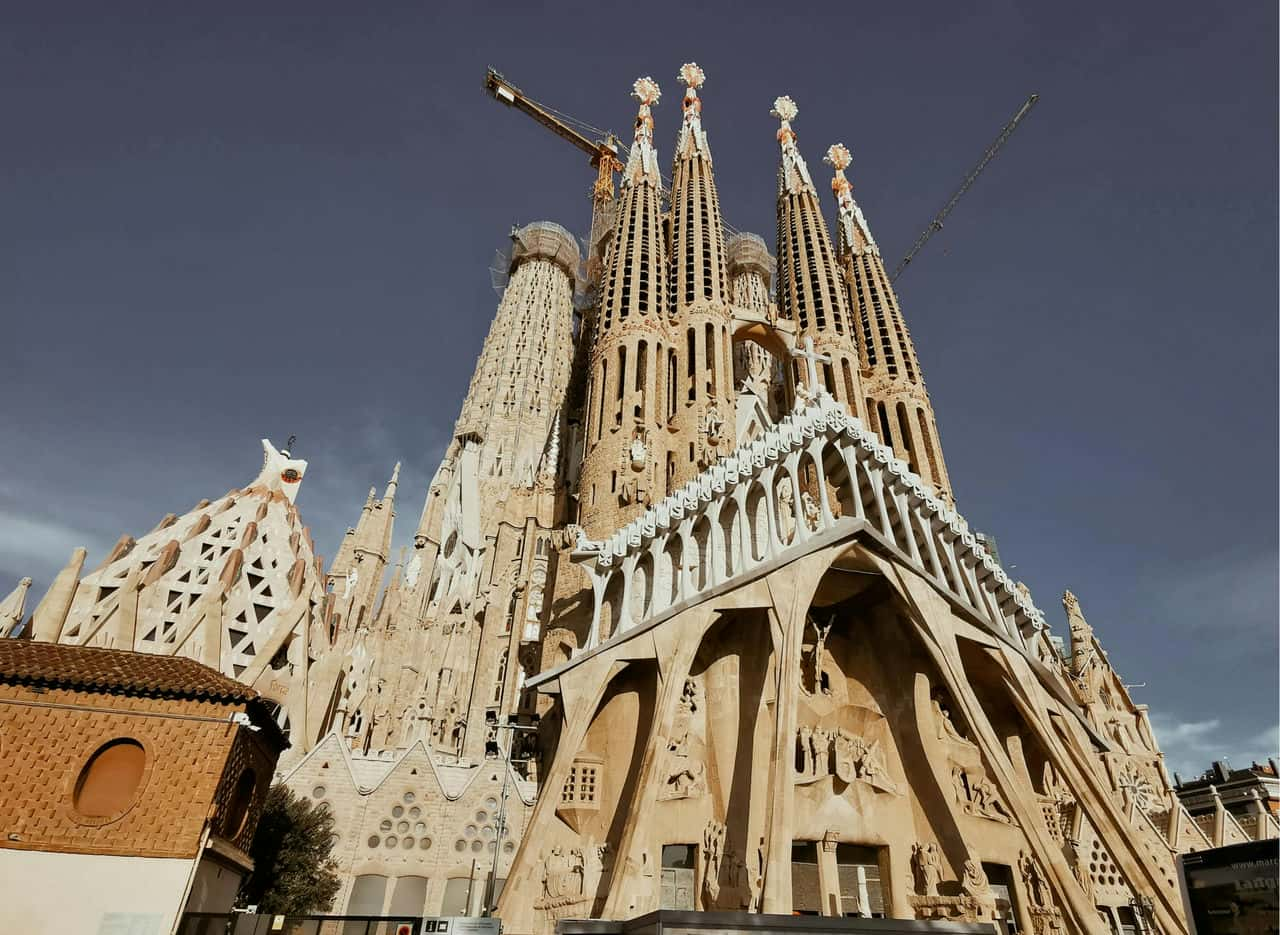
What are the challenges faced during the restoration of the Sagrada Familia?
There are 4 major challenges faced during the restoration of the Sagrada Familia. Firstly, the intricate and unique design of La Sagrada Familia poses challenges during restoration. The basilica’s distinctive architectural elements, such as the intricate facades, delicate sculptures, and intricate ornamentation, require specialized expertise and techniques to clean, repair, and restore. The preservation of the original design intent while addressing issues like weathering, deterioration, and structural stability is a delicate task that demands meticulous attention to detail. Secondly, the ongoing construction of La Sagrada Familia adds a layer of complexity to the restoration process. Restoration efforts must be coordinated with the construction activities as the basilica continues to be built. The coordination ensures that the restoration work does not interfere with the construction progress and that the newly built sections seamlessly integrate with the existing ones. It requires close collaboration between restoration teams and construction workers to preserve the historical elements while accommodating the evolving design. Thirdly, preserving Sagrada Familia’s historical and artistic value is a significant challenge. The basilica is a UNESCO World Heritage site and holds immense cultural significance. Restoration activities must adhere to strict conservation guidelines and ethical principles to preserve historical integrity. Balancing the need for restoration and repair with preserving original materials, finishes, and craftsmanship requires extensive research, documentation, and appropriate conservation techniques. Lastly, funding is a persistent challenge in restoring Sagrada Familia. The ongoing construction and restoration efforts require substantial financial resources. The basilica relies on public and private funding, including donations and revenue from tourism, to support these endeavors. Securing the necessary funds for ongoing restoration projects and ensuring the long-term financial sustainability of the basilica is an ongoing challenge that requires strategic planning, fundraising efforts, and the coordination of multiple stakeholders.
How does the Sagrada Familia comply with contemporary safety and accessibility standards?
The Sagrada Familia complies with contemporary safety and accessibility standards in 4 ways. Firstly, the basilica incorporates safety features to meet contemporary standards. Fire safety systems, including fire alarms, sprinkler systems, and emergency exits, are strategically placed throughout the building to ensure the safety of occupants. The structure’s design and materials are carefully chosen to provide optimal structural stability and resist seismic events, adhering to modern engineering principles. These safety considerations aim to protect visitors and occupants of La Sagrada Familia in an emergency. Secondly, Sagrada Familia strives to provide accessibility for individuals with disabilities. The basilica features ramps and elevators that allow wheelchair access to different areas, ensuring that visitors with mobility challenges can navigate the site comfortably. There are designated accessible parking spaces nearby to facilitate the arrival of visitors with disabilities. These accessibility measures align with contemporary standards and regulations, promoting inclusivity and equal access to the basilica’s spaces for all visitors. Thirdly, Sagrada Familia incorporates modern technology to enhance safety and accessibility. Advanced lighting systems are installed to illuminate the interior spaces, ensuring adequate visibility and reducing the risk of accidents. Signage and wayfinding systems are carefully placed to guide visitors and provide clear directions, enhancing the overall safety and accessibility of the site. Modern audio systems and multimedia installations provide information and interpretations for visitors, including those with hearing impairments, allowing for a more inclusive experience. Lastly, Sagrada Familia employs trained staff and security personnel to ensure visitors’ well-being and enforce safety measures. These staff members are knowledgeable about safety protocols and are available to assist visitors and answer questions. They play a crucial role in maintaining order, managing crowds, and providing necessary guidance to ensure a safe and accessible environment for visitors.
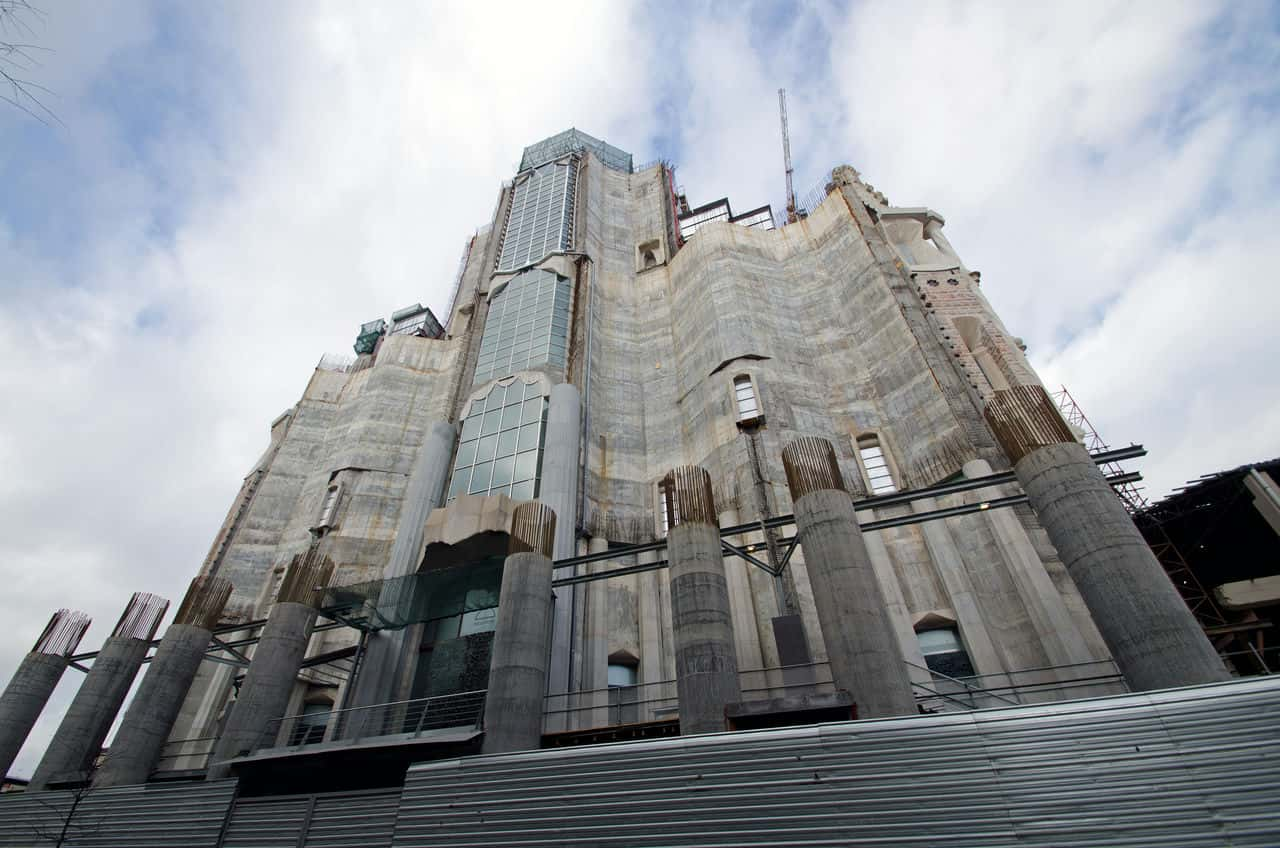
Are there any specific tours for architects or architecture enthusiasts to visit the Sagrada Familia?
Yes, there are some tours for architects or architecture enthusiasts to visit the Sagrada Familia. Sagrada Familia and Park Güell Tour includes priority access and entry tickets to the basilica and the park and a guided tour by an expert on Gaudi’s work. The tour lasts 3.5 hours and costs $72 (€65.52, £62.64)) per person. Modernism and Gaudi Guided Walking tour explores the best examples of Gaudi’s work and the modernist movement in Barcelona, including La Pedrera’s apartment and other buildings in Eixample. The tour lasts between 1 and 2.5 hours and costs $50 (€45.5, £43.5) per person. All the Sagrada Familia Architects tour focuses on the history and evolution of the basilica and the different architects who have worked on it since its inception. The tour covers the exterior and interior of the church, the museum, and the crypt. The tour lasts 2 hours and costs $38 (€34.58, £33.06) per person.
What lessons can architects learn from the design and construction of the Sagrada Familia?
There are 4 lessons that architects can learn from the design and construction of the Sagrada Familia. Firstly, the importance of a visionary and cohesive design is evident in the basilica. Architects can learn the significance of establishing a strong design concept and vision from the outset of a project. Sagrada Familia’s unique and recognizable design, inspired by nature and infused with symbolic elements, showcases the power of a well-defined architectural vision. Architects can learn to prioritize a clear design concept that guides the entire project, ensuring harmony and coherence in every design aspect. Secondly, using innovative construction techniques and materials in Sagrada Familia offers lessons in pushing the boundaries of architectural possibilities. Architects can learn the value of exploring new technologies and materials to achieve their design goals. Gaudí’s use of hyperboloid structures, intricate stone carvings, and innovative structural solutions demonstrates the potential for creativity and experimentation in architectural construction. Learning from Sagrada Familia, architects can embrace innovation to create unique and groundbreaking designs. Thirdly, the ongoing construction of La Sagrada Familia exemplifies the importance of collaboration and adaptability. Architects can learn the value of effective collaboration with engineers, builders, and craftsmen throughout construction. The basilica’s construction spans multiple generations, requiring seamless coordination and adaptation to evolving technologies and construction methodologies. Architects can learn to foster strong collaborative relationships and embrace flexibility to address challenges and successfully realize their architectural visions. Lastly, the commitment to the long-term vision and dedication to craftsmanship exhibited in Sagrada Familia offers lessons in patience and perseverance. Architects can learn the value of persistence and dedication to their projects despite obstacles and extended timelines. The basilica’s ongoing construction for over a century serves as a reminder that monumental architectural endeavors require enduring commitment. Architects can learn to maintain a long-term perspective, embrace the iterative design process, and remain dedicated to achieving excellence in their work.
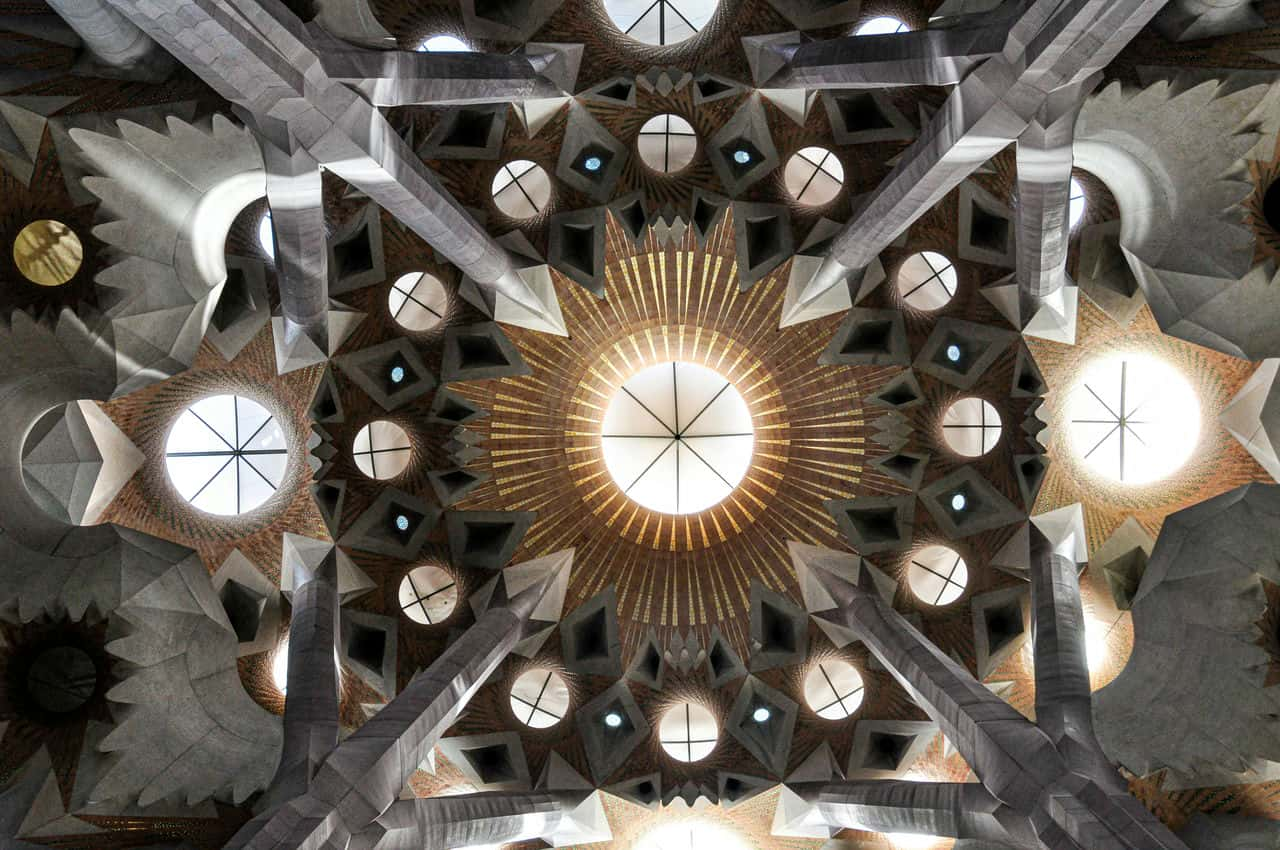
What are the best architectural landmarks to visit as an architect?
Listed below are the best architectural landmarks to visit as an architect:
- Sagrada Familia: The Sagrada Familia is an iconic basilica located in Barcelona, Spain. Designed by popular architect Antoni Gaudí, it is known for its unique and intricate architectural style that combines Gothic and Art Nouveau influences. The basilica has been under construction since 1882 and is still ongoing, making it a fascinating example of long-term architectural vision and dedication. Visitors can admire the stunning facades, soaring towers, and intricate details that make the Sagrada Familia a must-visit landmark for architects and enthusiasts alike.
- Taj Mahal: The Taj Mahal is a UNESCO World Heritage site in Agra, India. Built in the 17th century by Emperor Shah Jahan as a mausoleum for his beloved wife, it is considered one of the most beautiful examples of Mughal architecture. The Taj Mahal features intricate marble inlay work, symmetrical design elements, and a stunning white marble exterior. Its harmonious proportions and elegant details make it a masterpiece of architectural craftsmanship, attracting millions of visitors annually.
- Sydney Opera House: The Sydney Opera House is an iconic performing arts center in Sydney, Australia. Designed by Danish architect Jørn Utzon, it is known for its distinctive sail-like roof structure. The complex houses multiple performance venues and symbolizes modern expressionist architecture. Its innovative design and engineering challenges make it a significant landmark in architectural history. Visitors can take guided tours to explore the interior spaces and learn about the architectural concepts behind this world-famous structure.
- Guggenheim Museum Bilbao: The Guggenheim Museum Bilbao is a contemporary art museum in Bilbao, Spain. Designed by architect Frank Gehry, it is recognized for its striking, curvilinear form and titanium-clad exterior. The museum’s unconventional design pushes the boundaries of traditional architecture, creating a visually captivating and highly acclaimed landmark. Inside, visitors can experience a diverse collection of modern and contemporary art. The Guggenheim Museum Bilbao has revitalized the city, symbolizing urban regeneration through architecture.
- Fallingwater: Fallingwater is a residential house located in Mill Run, Pennsylvania. Designed by architect Frank Lloyd Wright, it is an iconic example of organic architecture that integrates seamlessly with its natural surroundings. The house is built over a waterfall and features cantilevered balconies and open spaces that blur the boundaries between indoors and outdoors. Fallingwater showcases Wright’s principles of harmony between architecture and nature, making it a significant landmark for architects interested in sustainable design.
- St. Peter’s Basilica: St. Peter’s Basilica is a major basilica in Vatican City, Rome. Designed by known architects, including Michelangelo and Gian Lorenzo Bernini, it is the largest church in the world and a masterpiece of Renaissance and Baroque architecture. The basilica’s grandeur is evident in its vast dome, intricate mosaics, and numerous works of art. Architects can appreciate the meticulous detailing and craftsmanship that went into creating this architectural marvel. Visitors can explore the interior, including the famous St. Peter’s Square, and marvel at its architectural and artistic splendor.
- The Louvre: The Louvre is a world-known art museum in Paris, France. Originally a medieval fortress, it was transformed into a grand palace and later became a museum. The Louvre is celebrated for its iconic glass pyramid entrance, designed by architect I.M. Pei. The museum houses an extensive collection of art and historical artifacts, including famous works such as the Mona Lisa. Architects can appreciate the museum’s architectural evolution, from its historic roots to the modern additions that have transformed it into a cultural landmark.
- Burj Khalifa: The Burj Khalifa is a skyscraper in Dubai, United Arab Emirates. Designed by the architectural firm Skidmore, Owings & Merrill, it is the tallest building in the world, standing at 2,717 feet (828 meters). The Burj Khalifa’s sleek and futuristic design features a stepped silhouette and a reflective glass facade. Its engineering marvels, such as the advanced structural systems and high-speed elevators, make it an impressive landmark for architects interested in tall building design. Visitors can enjoy panoramic views of Dubai from the observation decks on the upper floors.
- The Parthenon: The Parthenon is an ancient temple atop the Acropolis hill in Athens, Greece. Built in the 5th century BCE, it symbolizes classical Greek architecture and is one of the most influential buildings in Western history. The Parthenon showcases the Doric order with its iconic columns and pediments adorned with marble sculptures. Its harmonious proportions and refined architectural details demonstrate the principles of balance and symmetry. Architects can study the Parthenon’s design to understand the foundations of classical architecture and its enduring impact on architectural aesthetics.
- The Great Wall of China: The Great Wall of China is an ancient fortification that stretches across northern China. It is an architectural marvel and a UNESCO World Heritage site built over centuries. The wall showcases various construction techniques, including brick, stone, and rammed earth. Its strategic design incorporates watchtowers, battlements, and defensive features. The Great Wall’s vast scale and historical significance make it a remarkable landmark for architects interested in the intersection of architecture and military engineering. Visitors can explore different sections of the wall and admire the panoramic views of the surrounding landscapes.


